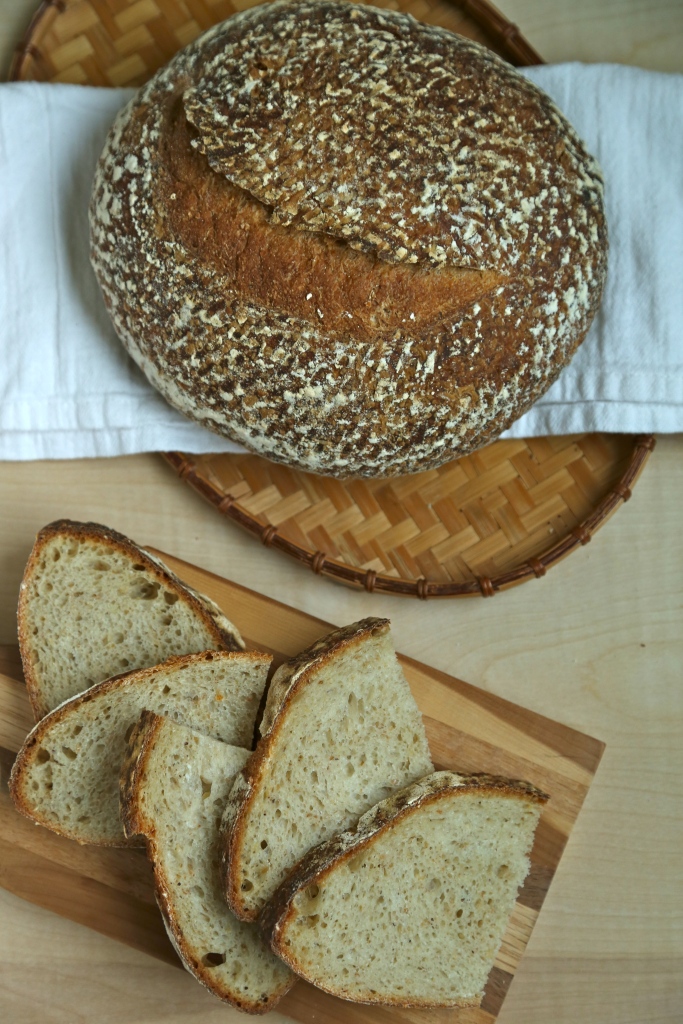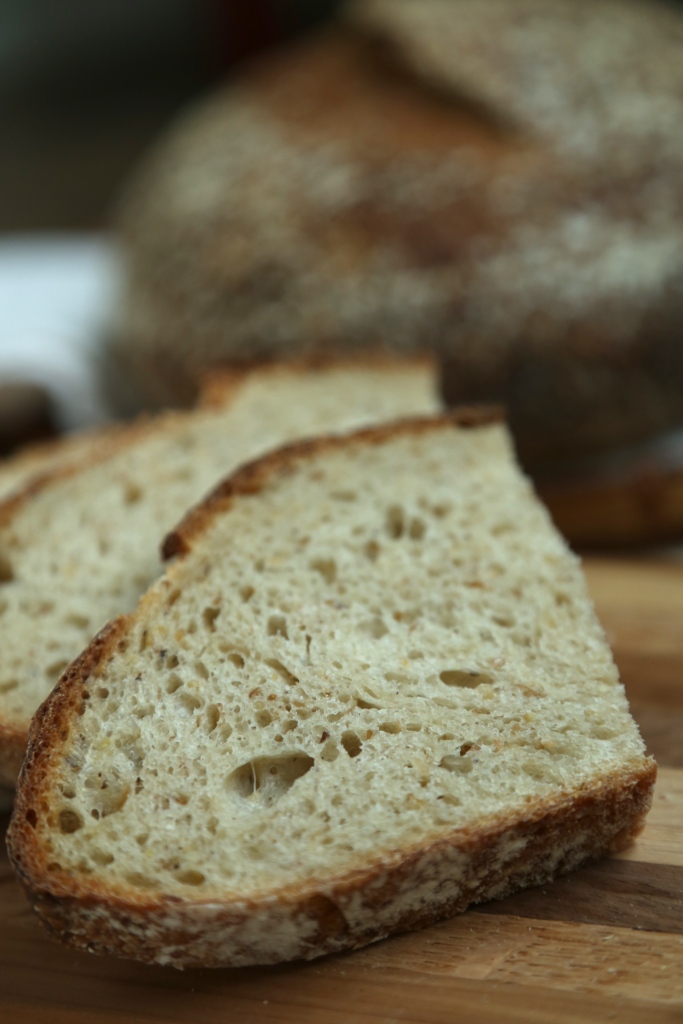 Fans of sourdough bread baking will most likely be familiar with Nancy Silverton’s book, Breads from the La Brea Bakery. Some folks would agree that it is one of the necessary “textbooks” on home baking of sourdough bread. When I found a copy of it at a local antique mall, I did not hesitate in making the purchase; this book has been on my “must buy” wish list for a long time. As a matter of fact, when I grew my own grape starter from the grapes growing in the Demonstration Garden at Ellington Ag Center in Nashville back in 2009, it was a method attributed to Ms. Silverton and now that I have the book to refer to, I can say it is her method but I only had half of the directions. The chapter on growing the starter, maintaining/replenishing it and using it is lengthy and a definite must read for anyone attempting one of the many recipes in the book.
Fans of sourdough bread baking will most likely be familiar with Nancy Silverton’s book, Breads from the La Brea Bakery. Some folks would agree that it is one of the necessary “textbooks” on home baking of sourdough bread. When I found a copy of it at a local antique mall, I did not hesitate in making the purchase; this book has been on my “must buy” wish list for a long time. As a matter of fact, when I grew my own grape starter from the grapes growing in the Demonstration Garden at Ellington Ag Center in Nashville back in 2009, it was a method attributed to Ms. Silverton and now that I have the book to refer to, I can say it is her method but I only had half of the directions. The chapter on growing the starter, maintaining/replenishing it and using it is lengthy and a definite must read for anyone attempting one of the many recipes in the book.
Recently, I made a batch of sourdough English muffins from the final chapter in the book. For those of you who have never looked at the book, the final chapter is a collection of recipes that give you a way to use excess starter that comes from the portion of starter that is discarded during feedings rather than the larger amounts grown in the majority of recipes throughout the book. A word of warning, most of the recipes in the book, including the last chapter, take a full two days to execute and this does not include the time necessary for a normal feeding of the starter. The English muffin recipe is a little different in that it is a single day recipe and also one that calls for both fresh yeast and starter.
 This recipe is the second bread recipe I have tried from the book, the first being the Country White loaves from the chapter on growing a starter, and it was a true learning experience. As with many of the recipes I have glanced at so far in this book, there is an ingredient list that is longer than you would expect and an equipment list that calls for specialized baking tools. Anyone who has ever been to my home knows that I do not generally shy away from purchasing tools and equipment. On occasion, I will try to use something similar rather than adding to the clutter unless it is a bundt pan or a cookie cutter; a baker can never have too many shapes to choose from. However, a long list of tools and ingredients that I must shop in several stores to find is always a little off putting, even for a dedicated baker like myself.
This recipe is the second bread recipe I have tried from the book, the first being the Country White loaves from the chapter on growing a starter, and it was a true learning experience. As with many of the recipes I have glanced at so far in this book, there is an ingredient list that is longer than you would expect and an equipment list that calls for specialized baking tools. Anyone who has ever been to my home knows that I do not generally shy away from purchasing tools and equipment. On occasion, I will try to use something similar rather than adding to the clutter unless it is a bundt pan or a cookie cutter; a baker can never have too many shapes to choose from. However, a long list of tools and ingredients that I must shop in several stores to find is always a little off putting, even for a dedicated baker like myself.
Besides the starter, this recipe called for milk, bread flour, dark rye flour, fresh yeast, wheat bran, wheat germ, flax seeds, rye chops or flakes, sunflower seeds, barley malt syrup, vegetable oil, sea salt, rice flour (just for dusting the dough), butter (for greasing the rings) and finally, semolina flour, also for dusting the dough but it was labeled as optional. That’s a lot of ingredients, a lot of ingredients that can be tricky to find in one store here, at least until Whole Foods opens in the summer. So with this in mind, please note my concern when I began mixing the dough and realized that I truly had a bowl of what looked a lot like lumpy porridge. After an extended shopping trip to find the ingredients and fermenting the sponge for about 2 hours, I was truly discouraged. Although I closely followed the recipe and made only on substitution-whole grain cooked cereal blend for the rye chops, I was at a loss for what I could have done wrong. In the end, I doubled the amount of flour in the dough from 8 ounces to a pound and finally had a dough that seemed to be what is called for in the recipe. Honestly, a book as technical as this one really should have more photos especially since so many steps in the recipes call for specific results and without photos, you have to rely on your interpretation of the wording.
 The recipe states that you should have a dough that is wet and sticky and may not hold its shape and I am pretty sure I nailed that part. It is dumped out onto a dusting of rice flour and covered with a dusting of rice or semolina flour and allowed to rest for 20 minutes before shaping.
The recipe states that you should have a dough that is wet and sticky and may not hold its shape and I am pretty sure I nailed that part. It is dumped out onto a dusting of rice flour and covered with a dusting of rice or semolina flour and allowed to rest for 20 minutes before shaping.
Remember my mention of specialized equipment? Well, I was hesitant to purchase English muffin rings because I did not want to have to find a place to store them. A suggestion in the recipe is to save tuna cans and cut the bottoms out to make your own rings. We do not eat that much tuna and if you have looked at a can of tuna lately, you have probably noticed that they no longer have a bottom that can be cut out, they are pressed from a single sheet and only the tops are removable which eliminated the cans as an alternative. Then while at work one morning, I spied cans from the crabmeat being used for crabcakes and thought they might work, they are a little tall, but the bottoms were removeable. There were 8 cans and that meant I could make either half a batch or do two bakes; I chose to do two bakes. In the future, I would attempt to get a weight on the entire batch of dough so that the muffins are of an equal size.
Here is the first batch rising in the crabby cans. Using the cans was okay, the strip of metal left from the top and bottom after removal was jagged and despite having used a pair of pliers to flatten the edges, the dough still stuck in the tiny crevices. The rough texture of the metal made getting the muffins out a bit of a chore. For the second bake, I buttered the cans and then dipped them in semolina and they definitely did not stick to the cans. The down side to the extra semolina, the muffins were coated in semolina which made them a bit messy to handle. Looks like I may make the plunge and buy rings or just start hoarding biscuit cutters!
 For a first attempt, they were pretty good. Not enough nooks and crannies when sliced with a knife but fork splitting them leaves bigger holes for the butter to collect in. Until next time, these are already gone!
For a first attempt, they were pretty good. Not enough nooks and crannies when sliced with a knife but fork splitting them leaves bigger holes for the butter to collect in. Until next time, these are already gone!





